QuestionMy General Maximus is six and a half. Right now, he's under the care of my mum and I'm a flight away. She called to tell me that she found him soiled and dragging his feet today. This is the first time it's ever happened. Over the past few months, his fur has fallen significantly and nothing grew back.He's still eating and drinking normally. The vet thinks it's spinal trauma and the fur loss is related to day-night disturbance, but I'm sure there is no chance of trauma, mostly because he sleeps in a draw and doesn't have to climb anywhere to get to anything. He says there is still sensation in the lower limbs and Max seems to have regained some semblance of bladder/anal tone. Apart from searching for a way to keep my little old man alive I am completely lost. It's bad enough that I'm so far away.I'm afraid an x-ray just won't help. The vet gave him an anti-inflammatory shot and sent him home with mum and now he's just resting. He's scheduled for an x-ray tomorrow morning. What tests should we do first? I'm so lost, any advice would be very much appreciated. Thanks.
AnswerHello Reens
Thank you for bringing him to the vet right away. It is important that such things as hind limb paralysis are seen ASAP. There are many potential causes for this presentation. These include: insulinoma (low glucose, spinal tumors, trauma, metabolic diseases, etc. and each needs to be ruled out. Also, keep in mind that a sick ferret can can show hind limb ataxia for no other reason that they are feeling too weak to move.
My hope is it is not a spinal tumor. These can come on suddenly and cause similar symptoms. Unfortunately spinal tumors are nearly impossible to diagnose without expensive tests. It is not something that shows up easily on all x-rays or blood-work.
Trauma is another potential cause, and there is a possibility to regain some function. It all depends on the extent of the damaged nerves, the age and the individual ferret. Spinal damage trauma is not as common as people suspect (considering it is so prevalent in dachshunds.. which are long like ferrets). It can happen, however, and still must be considered a possibility until proven otherwise.
I found an article on VIN (veterinary information network) regarding ferret hind-limb paralysis for your information. Unfortunately it focuses more on Insulinoma than trauma or spinal neoplasia, but it might be of some help. Please see below for the entire article.
The next step is an x-ray to see if there are any obvious lesions, but do not be surprised if this is inconclusive and he may require further tests. I would also have some blood work run on him. He is a geriatric ferret at over 6 years old, and metabolic disturbances can lead to toxic buildup in the blood, which can result in symptoms like hind end weakness. Also, blood-work is a good idea for a ferret of his age anyway, since there is the possibility of finding an unrelated problem and have the opportunity to treat it early.
-Cindy P.
Approach to the Ferret with Hindlimb Weakness
British Small Animal Veterinary Congress 2008
Nico J. Schoemaker, DVM, PhD, DECAMS, DABVP(Avian)
Division of Avian and Exotic Animal Medicine, Utrecht University
Utrecht, Netherlands
Both ataxia and posterior paresis are terms used when a ferret has a decreased ability to use its hind legs. As in both cases the neuromuscular system is involved it is clear that both deficits of neurological and muscular origin can result in onset of a certain degree of paresis (paralysis) or ataxia. Hind limb weakness can also have systemic circulatory causes. Actually, the most frequent cause of hind limb weakness is an insulinoma, but many other (debilitating) differentials should be considered. It should also be noted that lameness caused by orthopaedic problems can mimic weakness in the hind legs, and distinction between the two is thus very important.
Clinical Approach:
History
Within the history, it is important to focus on the progression and localisation of the disease. With regard to an insulinoma it is important to know whether the weakness is gradually getting worse, is stable and/or is seen only at certain periods (i.e., associated with prolonged periods of not eating, which resolves after a meal). It is also important to ask about signs of nausea (i.e., salivation and pawing at the mouth) and whether the ferret is periodically seen with a glazed look in its eyes. A constant, deteriorating weakness of the hind limbs does not fit within the history of a ferret with insulinoma.
Taking the other potential diagnoses into consideration it is important to ask routine internal medicine questions about diet, appetite, water intake, urination, vomiting, stool consistency, power of endurance, etc. To help differentiate between a systemic and a neurological disease it is also important to know whether other signs are present apart from the hind limb weakness, such as head tilt, leaning, circling etc.
Physical Examination:
During a complete physical examination the ferret's respiration should be observed while the animal is in a calm state. This is followed by counting the pulse frequency, which should not exceed 250 beats per minute, and a firm femoral pulse should be palpable. During auscultation no heart murmurs should be heard, and mucous membranes should be moist and pink.
When the history and the initial physical examination point towards an insulinoma, a fasting blood glucose (see later) will be measured at this stage. When the blood glucose is within normal limits, or when the history and examination point towards a neurological condition, a neurological examination is performed. First, inspection of locomotion can provide valuable information. Is the back still arched? Is there paresis or paralysis? Are only the hind limbs involved or is there paresis of the front legs as well? This is followed by the postural reactions, including the knuckling-over reflex, testing of tactile and optical placement of the legs, and hopping. The most commonly tested spinal reflexes are the patellar ligament reflex and the flexor reflex. Finally pain perception is evaluated.
Blood Examination:
A glucose measurement should be included in the evaluation of any ferret with hind limb weakness. Since blood glucose values can be normal after a meal, food should be withheld from the ferret for at least 4 hours. In-house glucose meters, intended for use in human diabetic patients, are calibrated to measure normal to high blood values. These meters therefore have a tendency to underestimate the actual blood glucose in the low range. When measuring a borderline low value, you should consider that the value may still be within the reference range. In these cases you can either prolong the fasting of the ferret for another hour, or send the blood to an official laboratory.
A complete blood count (CBC) and full plasma chemistry panel (including urea, calcium, sodium, potassium, inorganic phosphorus, aspartate aminotransferase (AST), bile acids, total protein and protein electrophoresis) should also be measured to assist you in differentiating between systemic causes when glucose levels are within the reference range. Insulin is not routinely measured by the author as this assay is not run on a regular basis in the Netherlands. Since the other causes of hypoglycaemia can usually be ruled out on the basis of the ferret's history, physical examination and plasma chemistry, a tentative diagnosis of insulinoma can be made.
A hypergammaglobulinaemia is suggestive of Aleutian disease. A positive antibody test (counterimmunoelectrophoresis (CIEP) or enzyme-linked immunosorbent assay (ELISA)) strengthens the diagnosis.
Diagnostic Imaging:
Diagnostic imaging is of no use in diagnosing an insulinoma in ferrets. The texture of insulinomas resembles that of surrounding fat, and the tumour is so small it cannot be distinguished during an ultrasonographic examination. Ultrasonography, however, can be of great value to evaluate abdominal structures. Echocardiography is also very helpful in diagnosing cardiac disease in ferrets.
Spinal radiographs may be of use to locate intervertebral disc disease, although a decreased space is usually barely detectable due to the size of the animals. Myelography, computed tomography or a magnetic resonance imaging (MRI) scan may assist in locating the herniated nucleus pulposi. Due to the size of the animal it is important to contact the radiologist prior to referral to ask whether the resolution of the equipment is sufficient for animals of this size. Spinal radiographs can be very useful in detecting osteolysis when neoplasias are responsible for the hind leg weakness.
Miscellaneous Tests
Cerebrospinal fluid (CSF) may be collected in the atlanto-occipital region and between L5 and L6. The CSF may be submitted for culture and cytology. Finally an electromyogram can be performed to see whether there is denervation or other neuromuscular abnormalities.
Treatment:
Insulinoma
Treatment of an insulinoma is possible by surgical resection of the tumour or by medical intervention. Within the pancreas multiple primordial insulinomas may be present, explaining why there is such a high recurrence rate after nodulectomy of an insulinoma. A partial pancreatectomy has therefore been recommended to increase the survival time. Removing too large a portion of the pancreas, however, may induce diabetes mellitus. When the insulinoma is found in the corpus of the pancreas, surgical removal is not possible due to proximity to the pancreatic duct.
Prednisone and diazoxide are the drugs which are described for the medical management of insulinomas. Although prednisolone is advised in most textbooks as drug of first choice, the author believes that this should be diazoxide, as this drug inhibits insulin release. Prednisone, which induces gluconeogenesis, seems to be very effective in practice, and side effects are hardly ever seen. The author, however, has seen a case of iatrogenic Cushing's disease in a ferret with long-term treatment with prednisone.
Treatment is started at a dose of 5 mg/kg diazoxide (orally q12h). The effect of treatment may be evaluated based on disappearance of clinical signs as well as on plasma glucose concentrations. Blood should be collected 4 hours after giving the diazoxide. During this period food should be withheld from the ferret. Although it has been mentioned that the dose of diazoxide may be increased to 30 mg/kg q12h, there is no actual upper limit of the dose. Potential gastrointestinal side effects (i.e., vomiting, diarrhoea), can easily be treated by lowering the dose of diazoxide, and adding prednisone (0.2-1 mg/kg orally q24h) to the treatment regimen. Medical management is usually sufficient for a period of 6-18 months.
Other Conditions:
The length of this abstract does not permit the author to discuss all treatment options for all differential diagnoses of hind leg weakness. In ferrets with cardiac disease it is important to decrease the workload of the heart. Diuretics, such as furosemide, are very useful. In addition, digoxin, angiotensin converting enzyme (ACE) inhibitors and pimobendan may be of use in regulating heart rate and blood pressure. Choice of one of these drugs is dependent on the outcome of the electrocardiogram (ECG) and ultrasound scan.
Aleutian Disease
Aleutian disease is uncommon in ferrets, but is frequently mentioned within the differential diagnosis in ferrets with hindlimb weakness. At least three different strains have been identified in ferrets. Most ferrets in which antibodies are found by CIEP will not develop any signs of disease. Different outbreaks, however, have been reported in which serious disease was seen in many ferrets. In 2005 and 2006, a Dutch ferret veterinarian (Hanneke Moorman) saw that in her practice many young ferrets died with unclear signs. Based on results obtained from the University of Georgia, she was able to diagnose a ferret with Aleutian disease. A serological survey among Dutch ferrets showed that 4.6% had a positive CIEP titre. Some of the affected ferrets died of the disease. The most prominent clinical signs in these ferrets were chronic wasting, paresis and/ or paralysis of the hind legs and urine and fecal incontinence. Some ferrets also showed signs of pneumonia, vomiting, diarrhea, uveitis and fever. Since the ferrets had either been imported from New Zealand or been in contact with ferrets from New Zealand, the import of these ferrets was discontinued. In 2007 Aleutian disease no longer seems to be a problem in the Dutch ferret population.

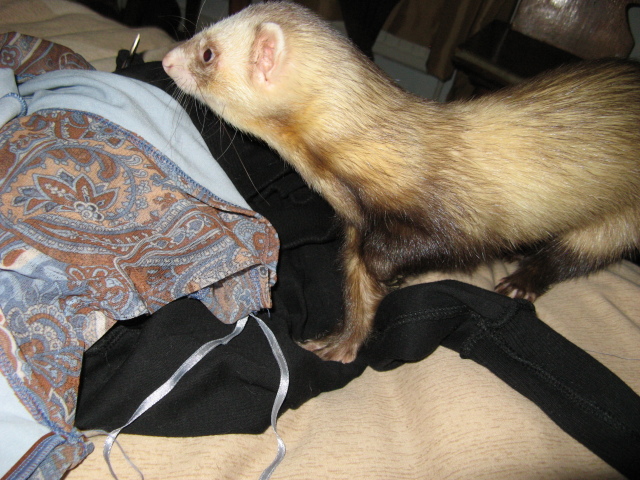 I think my ferret is to thin?
Question
Photo of Ferret
Hi
I think my ferret is to th
I think my ferret is to thin?
Question
Photo of Ferret
Hi
I think my ferret is to th
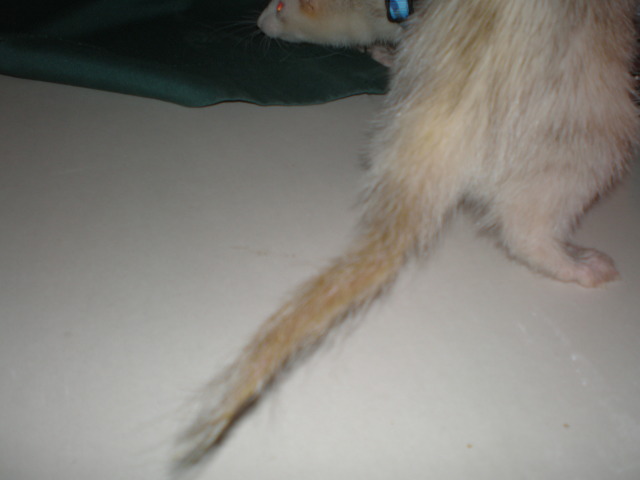 ferret stress
QuestionQUESTION: i just got a ferret and he is older i
ferret stress
QuestionQUESTION: i just got a ferret and he is older i
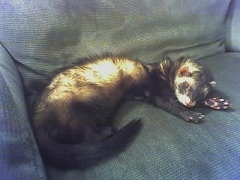 SWOLLEN FEMALE PARTS
QuestionSmokey napping
QUESTION: Hello, I have a
SWOLLEN FEMALE PARTS
QuestionSmokey napping
QUESTION: Hello, I have a
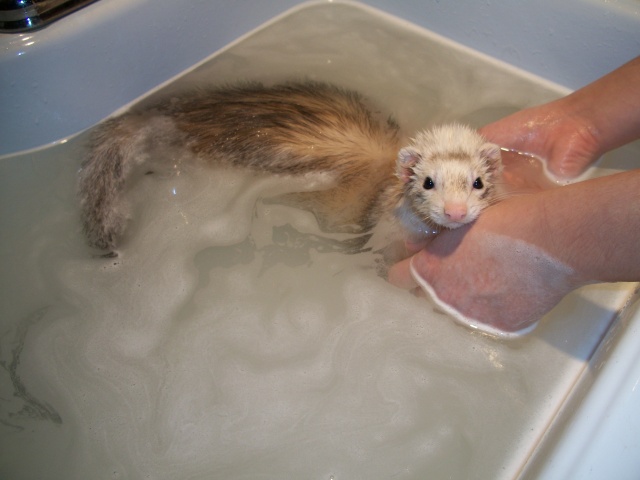 Just some basic help questions
Question
Benny!
Hi!
My ferret Benito (we just call him
Just some basic help questions
Question
Benny!
Hi!
My ferret Benito (we just call him
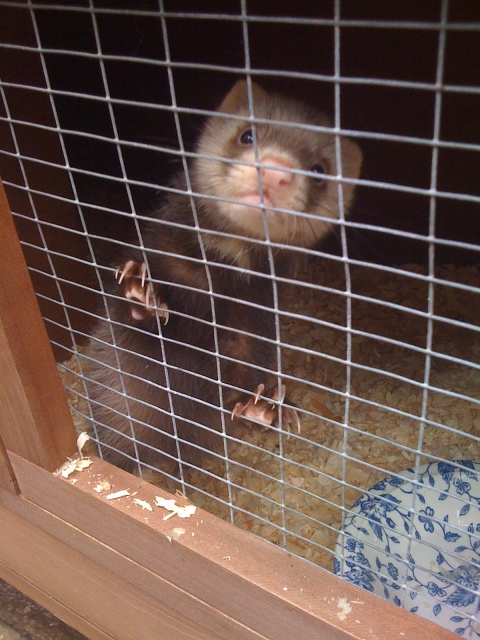 biting
Question
rascal
hey, i have just bought my first ever f
biting
Question
rascal
hey, i have just bought my first ever f